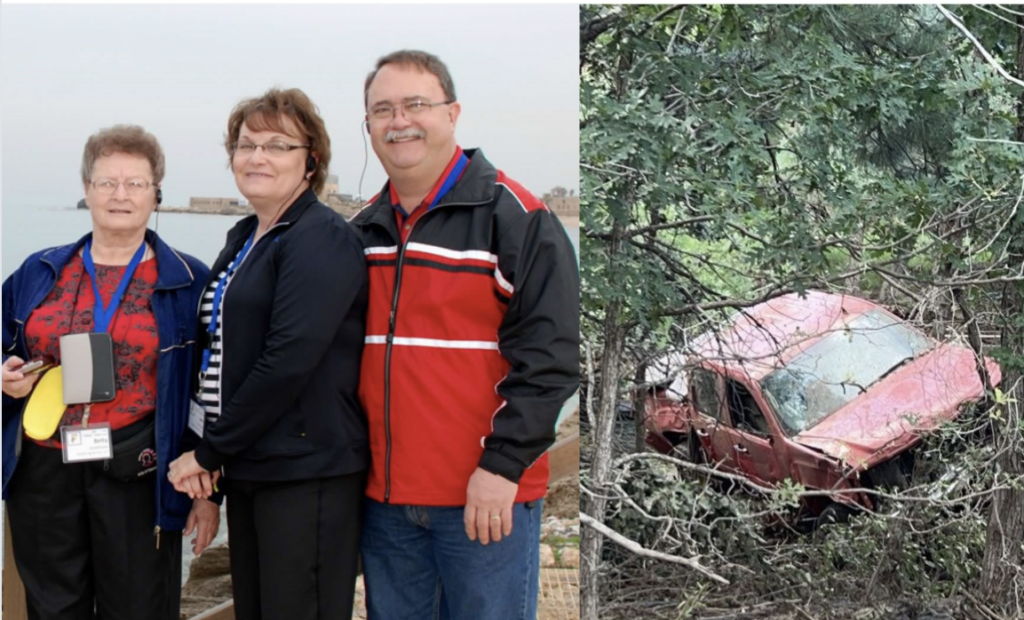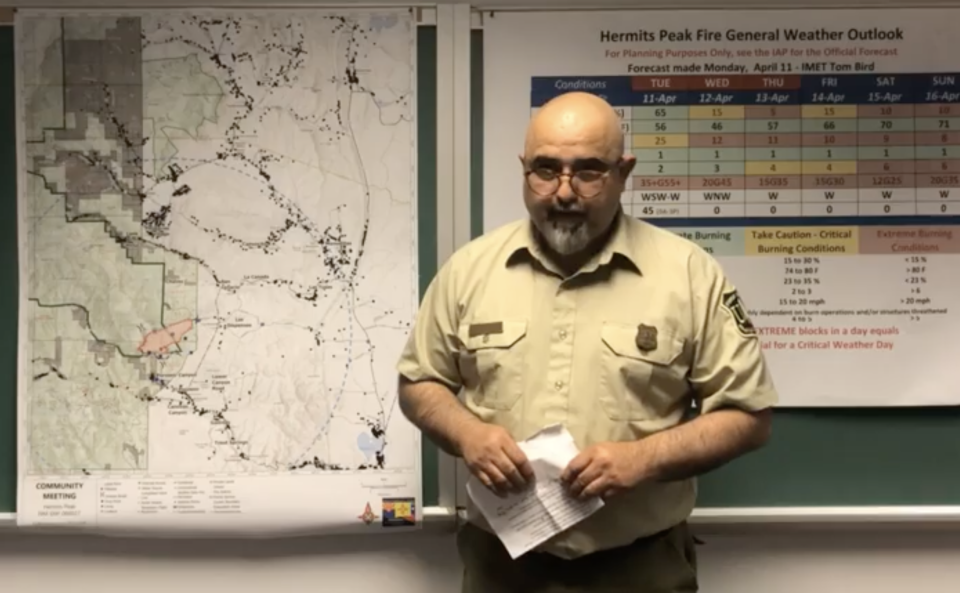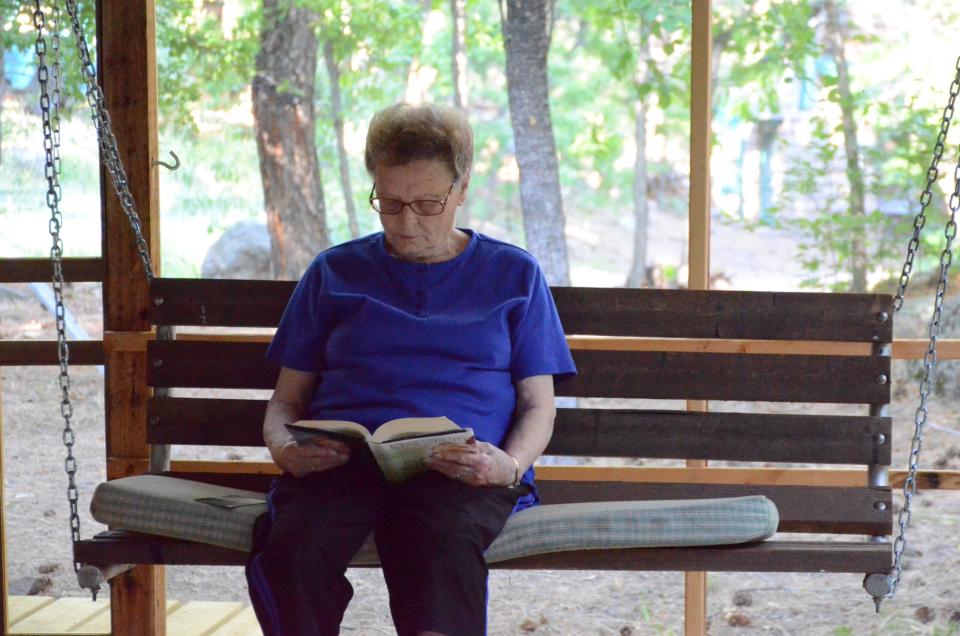Feds try to skirt responsibility in lawsuit for people who died after state’s biggest wildfire

LEFT: An undated, provided photo of Betty Lou Greenhaw, Jane Cummings and Chris Cummings, who all died in a flood stemming from the Hermits Peak-Calf Canyon Fire in July 2022. Despite the federal government taking responsibility for the wildfire, its lawyers are seeking to dismiss a wrongful death lawsuit on their behalf. RIGHT: The family's truck was also swept away when an 8-foot wall of water slammed their cabin near Mineral Hill, N.M. (Truck photo courtesy Russell Robinson)
Despite the federal government’s repeated apologies and promises to “fully compensate” victims for the biggest wildfire in state history, its attorneys are seeking to kill a lawsuit filed on behalf of three people who died in post-fire flooding.
The Hermits Peak-Calf Canyon Fire burned more than 530 square miles and destroyed several hundred homes. It also changed the northern New Mexico landscape for the foreseeable future, turning every rainstorm into a potential debris flow or flash flood.
In late-July 2022, as monsoon rains fell on scorched mountainsides, floodwaters jumped the banks of Tecolote Creek west of Las Vegas, N.M. The flood briefly submerged a playground near the creek’s banks, according to a National Weather Service report, and an eight-foot wall of water crashed into the sides of a nearby cabin.
The flood destroyed the cabin, sweeping three members of a Texas family — Betty Lou Greenhaw, 84, and Jane and Chris Cummings, both 62 — to their deaths by drowning and blunt-force trauma, according to their lawyer. The vacation home near the village of Mineral Hill had been in their family since 1965, their daughter told a local news outlet. It was their “favorite place in the world,” she said.
United States Forest Service employees ignited the two prescribed burns that escaped and combined to form the massive wildfire. The government’s lawyers argue that because they were acting within the scope of their duties when they did, the agency isn’t liable for their deaths.
Walker said the loss was devastating for their relatives. “Betty was a grandmother, a great-grandmother. Jane and Chris were parents, grandparents,” Walker said. “It was a tight-knit family.”
Their deaths were felt by people throughout the area and among staff at Camp Blue Haven, a Christian summer camp nearby. “These were people that we knew and loved. They were part of our extended family,” said Dan Burdett, the camp’s board president, in a video after their deaths.
As the wrongful death lawsuit plays out, it offers a test case of just how hard it is to sue the federal government, even for a mistake its officials have publicly apologized for, said Kate Ferlic, a New Mexico trial lawyer with a lot of experience suing under the Federal Tort Claims Act but no connection to the wildfire litigation.
“On one hand, the government’s certainly acknowledging their mistakes. But in the same breath, they’re saying, ‘Oh, sorry, but we don’t have to compensate you for those mistakes,” she said of the government’s motion to dismiss the flood lawsuit.
The United States Attorney’s Office’s approach in court also raises the prospect that the families of those who died due to the wildfire — those who lost the most in the sprawling disaster — could end up without a penny in damages.
The government’s lawyers are raising what’s called the “discretionary function” exception allowed under the Federal Tort Claims Act, which lets the government off the hook for damages if it can prove its employees were acting under a reasonable policy designed to defer to their expertise and discretion.
In this case, that could mean the Forest Service is not liable for the fire because its employees were given leeway on how best to manage the forest and protect it against future wildfire, the government’s lawyers are arguing.
The duties of managing the forest, including igniting prescribed burns, “all afford government employees significant discretion in weighing policy considerations and multiple objectives inherent in fire management,” they wrote in a February motion to dismiss.
The motion strikes a different tone than the one its client, the U.S. government, has taken repeatedly for the last two years. On April 11, 2022, for example, District Ranger Steve Romero offered the United States Forest Service’s first apology, doing so “with a heavy heart” at a community meeting just five days after the service started the Hermits Peak Fire.
Since then, federal officials have repeatedly said they take “full responsibility” for the fire and promised to make things right for the thousands of people it harmed. That includes a visit from President Joe Biden in June 2022, in which he said the federal government’s role in starting the fire means it has “a responsibility to help this state recover, to help the families who have been here for centuries.”
Lawyers for the government were expected to respond to Walker’s filing last week, but successfully got an extension to mid-July.
In a statement to Source New Mexico, a spokesperson for the United States Attorney’s Office said the government’s lawyers have no authority to provide compensation to victims outside of what the law allows.
A judicial ‘bait and switch’?
Florida-based attorney Daniel Walker, who is representing relatives of the family who died, issued a fiery response to the United States Attorney’s Office motion last month in federal court — full of italics, quotes and bold lettering for emphasis — saying the motion undermined federal officials’ public promises and the intent of a law Congress passed to compensate victims for the fire.
“Did Congress intend for such a judicial ‘bait and switch?’” he wrote in the May 6 filing. “Would it really confer upon the Government such a ‘liability escape hatch,’ after going to such lengths to admit liability and make clear it wants to compensate the victims of its actions?’”
In late September 2022, Congress passed the Hermits Peak-Calf Canyon Fire Assistance Act, which tasked the Federal Emergency Management Agency with establishing a new claims office and overseeing about $4 billion in compensation it awarded.
The act Congress passed says that the Forest Service has “assumed responsibility” for the fire and that the “United States should compensate the victims.”
As of June 7, the Claims Office has paid $770 million in more than 4,300 claims — about 20% of the total awarded by Congress. The office pays claims related to post-fire flood damage. Its policy guide mentions “flood” 79 times. And it has paid for nearly 2,800 flood insurance policies in the burn scar, accepting that residents of Mora County and San Miguel County now have a heightened flood risk.
The compensation program was an effort, members of Congress have said, to prevent victims from going through the hardship and expense of a lawsuit, offering instead to pay them for their losses administratively through a claims office.
But they said publicly and in the law itself that victims could always sue if they thought that was the right choice for them. A lawsuit brought under the Federal Tort Claims Act is listed as a “remedy” for victims in the act Congress passed, along with filing a claim with the Hermits Peak-Calf Canyon Fire Claims Office.
Walker said one reason he opted to file a lawsuit against the Forest Service instead of going through the claims office is that the office does not pay for hard-to-quantify aspects of loss, like compensation for pain and suffering and intangible benefits of a relationship lost.
FEMA has declined to pay so-called “noneconomic losses” through the claims office, saying the law Congress passed does not allow it to do so. That’s the subject of ongoing litigation, as well.
The claims office also “does not have a specific policy” to compensate families for deaths of relatives, Deborah Martinez, a spokesperson for the FEMA claims office, told Source New Mexico.
Instead, any compensation offered would be limited to “quantifiable financial losses,” like loss of a deceased person’s income, she said. The office would also pay for a coffin or a tombstone, she said.
The legal dispute gives a sign of what might come next for thousands of fire victims, including many frustrated with the claims office. In April, law firms representing more than 2,400 fire victims filed forms preserving their rights to sue under the Federal Tort Claims Act.
The law firms did so because of the legal deadline to file the forms and also because of the challenges they say they continue to face with the claims office.
Tessa Duberry, the U.S. Attorney’s Office spokesperson, said she “cannot speculate” whether the office will take the same approach if it’s faced with thousands of lawsuits on behalf of people harmed by the fire or its aftermath.
Absurdity doctrine
Ferlic has represented plaintiffs suing under the Federal Tort Claims Act many times, she said, including suing the Environmental Protection Agency after the Gold King Mine Spill in northwest New Mexico in 2016, which turned the Animas River yellow with heavy metals and other contaminants.
She said, in her experience, the government is increasingly invoking the “discretionary function” exception to let itself off the hook, taking advantage of the strong protections the government created to protect itself from frivolous lawsuits, judicial second-guessing or being sued into oblivion for doing its job.
Private companies have no such protections, she noted, and there would be no question that a private utility company, for example, would be on the hook for the flooding deaths in the same situation.
What makes this lawsuit different, and perhaps even unprecedented, Ferlic said, is the fact that Congress reached a rare agreement to compensate victims for a disaster the federal government caused, and still the United States Attorney’s Office is seeking to eliminate liability.
“I think that the plaintiffs raise a really interesting argument, and one that could be novel for the court,” she said. “And that is, when Congress accepts responsibility and makes an appropriation to remedy their negligence, that it is potentially waiving the discretionary function exception defense.”
Walker, in court filings, wrote he is hoping the judge will agree that the government’s motion to dismiss contradicts Congress’ intent that the government be held liable for the wildfire.
He said he hopes the judge will invoke what’s called the “absurdity doctrine,” which allows the plain text of a law to be ignored if it would lead to an “absurd outcome,” according to Walker’s filing. The doctrine is rarely applied, but he said it clearly applies in this case.
“If under the plain language of this statute, the United States Government were allowed to argue the ‘discretionary function exception’ to immunize itself from the liability Congress clearly conferred upon it, that would not only ‘yield patent absurdity,’ it would also ‘produce an illogical result,’” he wrote.
If his argument about the absurdity of the government’s motion doesn’t succeed, Walker will need to show that the Forest Service violated specific policies in lighting the fire. Walker’s lawsuit notes that the Forest Service went against its own burn plan for the fire, including igniting despite a relative humidity lower than the plan called for and not having minimum back-up required in the plan.
He also said officials failed to adequately warn the public about the threat of post-fire flooding; the government denies that.
No settlement
Before the lawsuit was filed last spring, the U.S. Attorney’s Office had six months to offer a settlement to the victims’ family before Walker was able to sue in federal court, Walker and Ferlic noted, and could have responded to each of the allegations in the lawsuit.
Instead, the government’s lawyers moved to dismiss the lawsuit entirely, a move that suggests they are pulling out all the stops to pay little or no damages to the family, Ferlic and Walker said.
Tessa Duberry, a spokesperson for the United States Attorney’s Office in New Mexico, did not specifically address why the government didn’t offer to settle the case. But she said the attorneys had no choice but to adopt this legal strategy, saying the office lacks the authority to act outside of what the law requires.
“The government must follow the compensation requirements set out by Congress in the Hermit’s Peak-Calf Canyon Fire Assistance Act and the Federal Tort Claims Act,” Duberry said. “Federal agencies lack the authority to provide compensation outside the specific categories outlined in these two legislative acts and cannot extend liability beyond the limitations imposed by Congress.”
Ferlic also said Congress could have imposed restrictions on how the U.S. Attorney’s Office handles lawsuits stemming from the fire, specifically by requiring in their law that the office not raise the “discretionary function” exception of the Federal Tort Claims Act.
U.S. Rep. Teresa Leger Fernandez and U.S. Sen. Ben Ray Lujan drafted the Hermits Peak-Calf Canyon Fire Assistance Act. Leger Fernandez’s office declined to comment on the legal strategy of the United States Attorney’s Office. Lujan’s office did not respond to repeated requests for comment.
The post Feds try to skirt responsibility in lawsuit for people who died after state’s biggest wildfire appeared first on Source New Mexico.



